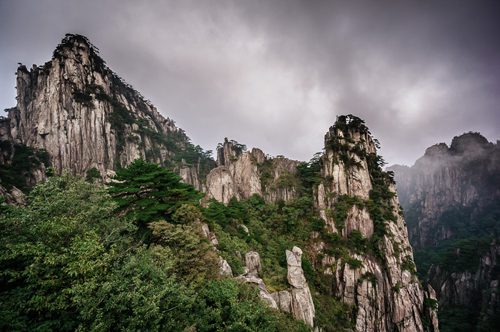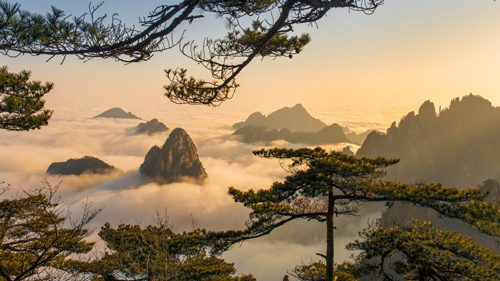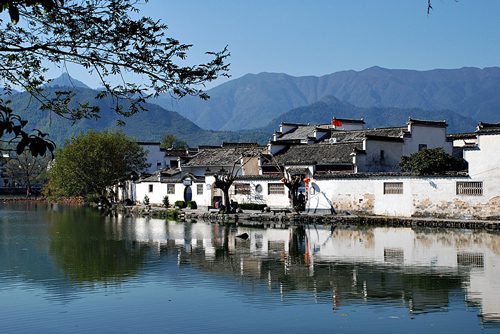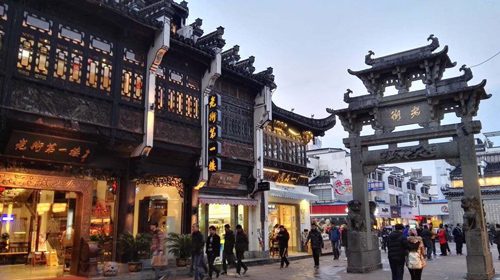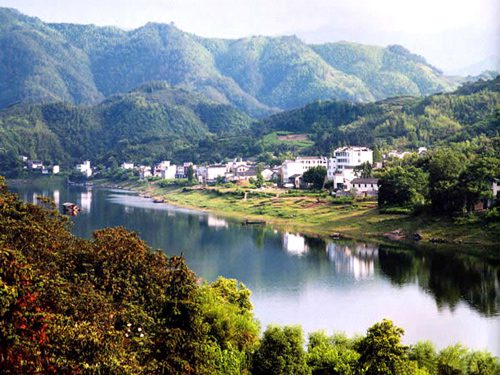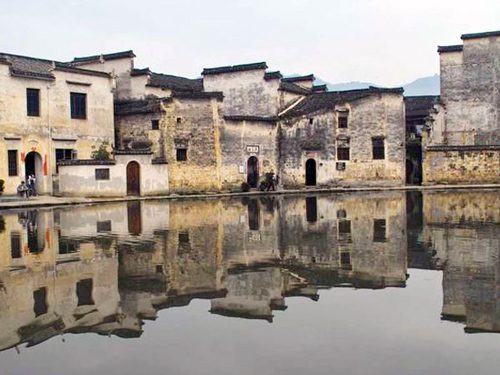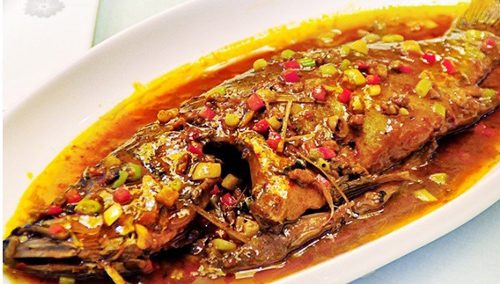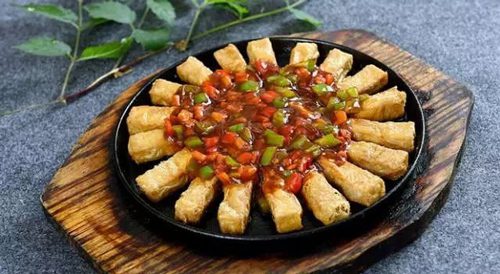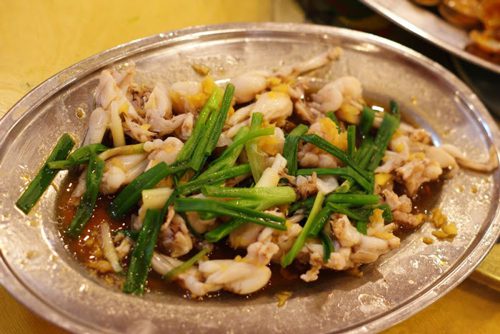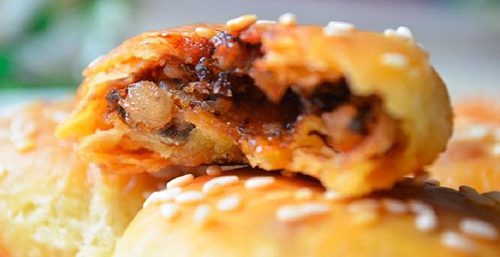Located in the east of China, Huangshan is a popular tourist destination for its long 2000-year-old history and spectacular sceneries. Literally, Huangshan means ‘Yellow Mountain’ in local language and the city was named after its most lovable scenic spot. Picturesque Mount Huangshan or Yellow Mountain is 64 kilometers away from the city center. This place attracts millions of tourists every year and it cannot be missed for the ones who are into adventurous and ecotourism travel.
Best Time to Travel to Huangshan
Huangshan is cloudy, foggy and humid around the year. The best time to visit Huangshan is from April to October. It rains in spring (March – May) and summer (June – August) in this city, so prepare a raincoat. Winter is the low season since it is chilly in the mountainous area.
Huangshan Travel Tips
Trekking to Mount Huangshan is an exciting activity in your Huangshan trip. We have some safety tips for your trekking journey:

- Yellow Mountains
What to pack?
- Warm clothing: The higher you get to the mountain peak, the more remarkable temperature decreases. Keep yourself warm especially in early morning and evening as well as during winters. Waterproof coats are necessary for winters. Don’t forget to bring extra clothes.
- Raincoat: We don’t recommend an umbrella since the wind is strong here.
- A good pair of shoes according to the season: Waterproof walking shoes or trekking boots are essential in the winter.
- Essential gears and equipment
- Food and drink: Bring high-calorie snacks and some bottles of water, it will be hard to buy food and drink around Mount Huangshan area.
- A map for reference
- Don’t forget your camera; the view is spectacular in this place.
Some safety tips:
- The front of Mount Huangshan is more dangerous than the rear. Walk slowly to ensure that you will not slip.
- Trekking is not recommended for elderly people and those with health problems. It is advisable to take the cable car to appreciate the beauty of this place.
- Although the Yellow Mountain is wonderful in winter, we recommend you to take a cable car since it may be too slippery for hiking, especially when it snows.
What to See in Huangshan
1. The Yellow Mountains

- Yellow Mountains
This is one of the loveliest attractions in China. Trek lovers will be thrilled by amazing granite peaks, evergreen pine forests, spectacular grottoes and unforgettable views of the clouds. Thanks to its mists and clouds, this mountain becomes more mysterious and attractive. This attraction can be divided into 7 areas: Beihai Scenic Area, Xihai Scenic Area, Songgu Scenic Area, Yungu Scenic Area, Yuping Scenic Area, Baiyun Scenic Area and Hot Spring Scenic Area.
It is obvious that it will take a lot of times to visit all those 7 areas. Hence, we suggest 6 spots for you: Bright Summit Peak, Lotus Peak, Flying-Over Stone, West Sea Grand Canyon, Cloud Pavilion in the Grand Canyon of Xihai and Greeting Guest Pine. If you are not into trekking, there are 4 cable cars for you to get to the mountain peaks. Don’t forget to take photographs of magnificent sunrise and sunset in Mount Huangshan.
2. Hongcun Village

- Hongcun Village
Hongcun Village is famous for natural sceneries and over 140 well-preserved ancient houses of the Ming and Qing dynasties. Thanks to Director Ang Lee who chose Hongcun Village for many scenes in the film Wo Hu Cang Long (Crouching Tiger Hidden Dragon), this village now becomes a popular tourist destination. The system of streams and rivers in this village contributes to Hongcun’s quaint and quiet features. This is the place where you can take stunning pictures of rustic ancient houses, lush green trees and beautiful mountains reflecting on the lake at dawn.
3. Xidi Village

- Xidi Village
Less touristy and crowded than Hongcun Village, Xidi Village is the place for rustic wooden houses from the Ming and Qing dynasties. Only a half hour drive from the center of Huangshan, Xidi Village will delight history lovers with unique architecture and a rich history of 1000 years. There are more than 100 houses which retain their architecture of the dynastic period. This village was recognized as a UNESCO Heritage site in 2000. The best times to visit Xidi Village are spring (March-April) and early autumn (October-early November) due to the pleasant weather here.
4. Tunxi Ancient Street

- Tunxi Old Street
Located at the center of Tunxi District, Tunxi Ancient Street is well-known for its Anhui architecture and souvenir shops. With only 1.5 kilometers in length, this street is small yet elegant and sophisticated. Tunxi is famous for producing high-quality tea and ink. You can visit Tunxi’s old ink factory and discover how ink was produced during the ancient time. Moreover, tourists will have a chance to understand the value of the Four Treasures in Chinese calligraphy tradition – brush, ink, paper and ink stone.
5. Xin An River

- Xin An River
Located at the foot of the Yellow Mountain, Xin An River is the essential waterway for the local people. There are many ancient villages along the upstream section of this river, which make hiking along this river popular recently. There are many charming fields along the river, and they are even more beautiful in spring when rape flowers bloom. Clear water, imposing mountains and yellow rape flowers will be perfect scenery for your photos.
What to Do in Huangshan?
Visit the Mount Huangshan
Mount Huang (Yellow Mountain) is a destination for those who love adventure travel. This place features stunning mountain peaks, magnificent cliffs, mysterious caves and splendid trails. Frequently covered by mists, this mountain is like heaven on earth that will captivate anyone who admires the captivating nature. Yellow Mountain was awarded as World Heritage site by UNESCO in 1990.
Discover Chinese history and culture in some ancient towns and streets

- Hongcun Village
- Hongcun Village: Thanks to Director Ang Lee who chose Hongcun Village for many scenes in the film Wo Hu Cang Long (Crouching Tiger Hidden Dragon), this village now becomes a popular tourist destination.
- Xidi Village: Less touristy and crowded than Hongcun Village, Xidi Village is the place for rustic wooden houses from the Ming and Qing dynasties.
- Tunxi Ancient Street: Located at the center of Tunxi District, Tunxi Ancient Street is well-known for its Anhui architecture and souvenir shops.
- Tachuan Village: Only 2 kilometers from Hongcun Village, Tachuan Village is really beautiful when the leaves change their color in autumn.
What to Eat in Huangshan
The cuisine of Huangshan can be categorized as one branch of Anhui Cuisine (or Hui cuisine), which is one of Eight Major Cuisines in China. Although it is not as popular as Cantonese cuisine or Sichuan cuisine, Anhui Cuisine is sophisticated with beautiful appearance and aromatic taste. Originated during the South Song Dynasty (1127-1279), Huangshan chefs have been using fresh ingredients from both land and sea such a long time. Fresh vegetables, mushrooms, poultry, fish and shrimps are carefully chosen to cook mouth-watering and savory dishes.
The main cooking methods of Hui cuisine are braising in soy sauce, stewing and steaming, not frying like other regions in China. The temperature is strictly controlled when cooking; the chefs will increase or decrease the fire accordingly. People in Huangshan pay a special attention to the color of the dish; they always ensure that the appearance is as appealing as the aroma and taste. Huangshan foods are just slightly spicy and salty, which are suitable for foreign travelers. Some signature dishes here are Mandarin Fish, Mao Tofu, Yellow Crab Shell Cake and Stewed Soft-shelled Turtle.
1. Chou Guiyu (Smelly Mandarin Fish)

- Chou Guiyu (Smelly Mandarin Fish)
With the history of more than 200 years, Chou Guiyu is the signature food of Huangshan. Despite its not-so-delicious name, this food attracts many travelers for its tender and juicy taste. Xin An River and other streams are the main sources of Mandarin Fish.
This fish is called Smelly Mandarin Fish because of its smelly skin which is used to protect itself from enemies. When cooking, this smelly skin will be removed. The fish is salted for a week. After that, it is braised with soy sauce and bamboo shoots.
2. Mao Tofu (Hairy Fermented Tofu)

- Mao Tofu (Hairy Fermented Tofu)
This food is also known as Huizhou funky bean curd. Mao Tofu is fermented with some special ingredients and then fried to have an eye-catchy golden color. Mao Tofu has a strong smell, but the taste is excellent. You can find this food in some street food vendors around Huangshan’s ancient towns.
3. Steamed Shiji

- Steamed Shiji
Shiji is known as a popular kind of frog living in some streams along Mount Huangshan. Shiji is steamed in traditional Chinese bamboo steamers with a sauce of ham and fungi. Don’t be scared of this dish, its taste is really tender and refreshing.
4. Yellow Crab Shell Cake

- Yellow Crab Shell Cake
Yellow Crab Shell Cake is a Huangshan’s well-known local snack. This food is made from high-quality flour and filled with fatty meat, dried vegetables and sesame. After being roasted on charcoal fire, this cake has the similar color to boiled crab shell. It tastes crispy and delicious with juicy meat and vegetables inside. You can find Yellow Crab Shell Cake in many local street food stalls.
Some famous restaurants in Huangshan
- Laojie Diyi Lou: 247, Tunxi Ancient Street
- Tunxi Huicai Guan: Huangshan West Road, Tunxi District
- Piyun Hui Fu Cai: 7-9 Binjiang Road East
- Hui Shang Gu Li: 12 Xianrendong Road, Tunxi District
- Meishi Renjia: Tunxi Ancient Street
- Leigang Restaurant: Hongcun Village

